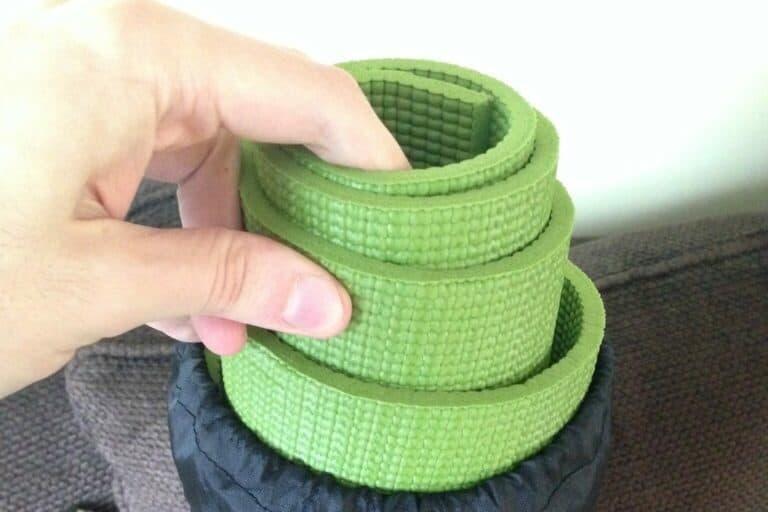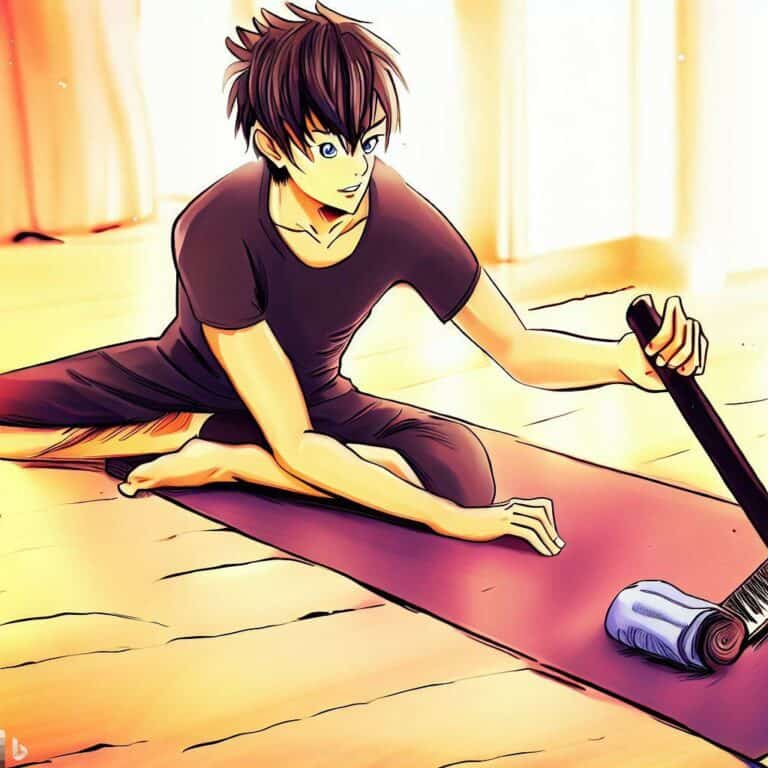Cleaning Yoga Blocks: A Comprehensive Guide to Block the Damage

Intro to Cleaning Yoga Blocks
If you’re a yogi, you know the importance of having a good set of yoga blocks. They are an essential prop that can be used for support, stability, and alignment during your practice.
However, like any other yoga accessory, they require proper care and maintenance to ensure their longevity. In this article, we will be discussing some helpful tips on how to clean yoga blocks so that they last longer and serve you well throughout your yoga journey.
From cleaning to storing and maintaining the shape and texture of your blocks, we’ve got you covered. So let’s dive in!
- This article provides a comprehensive guide on how to clean yoga blocks for maintenance and longevity.
- Regular cleaning is important to prevent the buildup of dirt, bacteria, and odors on the blocks.
- Proper storage in a cool, dry place away from direct sunlight is recommended, and signs of wear and tear indicate when it’s time to replace the blocks.
The Importance of Caring for Yoga Blocks
Just like any other object that is frequently used in your day-to-day life, yoga blocks can accumulate dirt and grime over time. If left uncleaned or uncared for, they can start to smell bad or even harbor bacteria that can cause infections or illnesses.
Additionally, regular use of yoga blocks can cause wear and tear on their surface texture or even lead to deformity if not properly maintained. Taking care of your yoga blocks not only ensures their longevity but also helps keep them hygienic for safer use.
Cleaning your yoga blocks
One of the most important things you can do to care for your yoga blocks is to clean them regularly. Not only does cleaning prevent the buildup of bacteria, but it also helps keep your blocks looking great and free from any smells. If you use your blocks frequently, it’s a good idea to clean them once every week or two.
Importance of cleaning regularly
When you’re practicing yoga, the last thing you want is to be touching dirty or smelly props. Regular cleaning ensures that your block remains a safe and sanitary tool that you can rely on for support during your practice.
Yoga blocks are porous, which means they can trap bacteria and sweat over time if not cleaned properly. Cleaning also helps maintain the texture of the block and prolongs its lifespan.
Related topics:
A Guide to Cleaning Your Yoga Mat with Vinegar
The Ultimate Guide to Keeping Your Yoga Mat Fresh and Clean
Sweat, Cleanse, Repeat: The Ultimate Guide to Keeping Your Jute Yoga Mat Spotless
Sustainable Serenity: The Ultimate Guide to Cleaning and Caring for Your Cork Yoga Mat
Clean, Refresh, and Revive: The Ultimate Guide to Keeping Your Natural Rubber Yoga Mat in Top Condition
Materials needed for cleaning
Cleaning yoga blocks is a straightforward process, and it doesn’t require any special equipment or materials. All you’ll need is warm water and mild soap or detergent (dish soap works well), a towel, and a sponge or scrub brush if needed.

Step-by-step instructions for cleaning
To clean your yoga block effectively, start by filling up a sink or bucket with warm water and adding a few drops of soap or detergent. Place the block in the water and use a sponge to gently scrub off any dirt or grime in circular motions.
Make sure to get all sides of the block thoroughly! Once you’ve finished scrubbing, rinse the block off with warm water until all suds are removed.
Use a towel to pat dry any excess moisture before storing away. If your block still smells funky after rinsing it off, consider using vinegar instead of soap as an alternative cleaner – simply add 1 part vinegar into 4 parts warm water when filling up your sink.
Storing your yoga blocks
Once you have cleaned your yoga blocks, the next step is finding the right place to store them. Proper storage ensures that they are protected from damage and will last for a long time. The best way to store your yoga blocks is in a cool, dry and clean place, free from direct sunlight or moisture.
Avoid storing them in places that are subject to temperature fluctuations such as basements or attics. If you practice yoga at home, storing the blocks near your mat will help you remember to use them more often.
You can stack them neatly on a shelf or keep them in a basket near your mat. This also makes it easier for you to grab them quickly during your practice without disrupting the flow of movements.
Tips on where to store them
If you don’t have much space at home, there are still many creative storage solutions available. For example, some yogis choose to hang their blocks on hooks on their walls or even on their doors using over-the-door hangers. This not only saves space but also makes it easy for you to find and grab the block when needed.
Another popular option is using a yoga block rack specifically designed for storing yoga blocks. These racks come in various sizes and shapes and can be placed anywhere in your home; they are especially useful if you have multiple different size blocks that need organizing.
Some racks even include hooks for holding other props such as straps or blankets. Overall, choosing the right storage space is important for prolonging the life of your yoga block while keeping it easily accessible when needed during practice.
Maintaining the shape and texture of your yoga blocks
Yoga blocks are essential tools for most yogis, and to get the most out of them, you need to ensure that they retain their shape and texture. With prolonged use, they can get deformed or lose their grip, which can affect your practice. Here’s what you need to know about maintaining your yoga blocks:
Avoiding exposure to extreme temperatures and direct sunlight
One way to maintain the shape and texture of your yoga blocks is by avoiding exposure to extreme temperatures. This means keeping them away from sources of heat such as radiators or direct sunlight, which can cause warping or cracking. When you’re not using them, store them in an area with consistent temperature levels.
If you live in a place with a humid climate, it’s best to store your yoga blocks in a dry place to prevent moisture buildup that could lead to mold growth. In case they do get wet or damp during use, wipe them down with a clean towel before storing.
Tips on how to maintain the texture
The texture of yoga blocks is another important aspect that can affect your practice. Over time, the surface may become smooth due to wear and tear or the accumulation of sweat.
To maintain the texture of your yoga blocks, try using a non-slip mat underneath them during practice. This will help reduce friction between the block and surface and therefore prolong their lifespan.
Another tip is to clean them regularly with mild soap or detergent solutions. This will remove any dirt or grime buildup on the surface that could reduce their grip.
Maintaining the shape and texture of your yoga blocks is crucial if you want them to last long without affecting your practice negatively. Follow these tips regularly for better results!
Replacing your yoga blocks
Signs that it’s time to replace them
Yoga blocks are an essential accessory for any yoga practice. They provide support and stability, helping you deepen your stretches and poses.
But like any other piece of equipment, they can wear out over time. So how do you know when it’s time to replace them?
Here are some signs to look out for: 1. Cracks or chips: If your yoga blocks have cracks or chips on the surface, it’s time to say goodbye.
These small flaws can lead to more dangerous damage in the future. 2. Compression: Yoga blocks are designed to be firm and supportive, but over time they can lose their shape due to compression from repeated use.
If your block is no longer providing the support you need, it may be time for a replacement. 3. Wear and tear: If your block is looking worn and ragged, with peeling surfaces or frayed edges, it’s probably seen better days.
How often you should replace them
The frequency of replacement depends on how often you use your yoga blocks and how well you take care of them. On average, with regular use and proper maintenance (cleaning regularly, avoiding extreme temperatures), yoga blocks can last up to 5 years.
However, if you’re a frequent yogi who practices daily or multiple times a week, that lifespan may be shorter due to increased wear and tear. It’s important to inspect your yoga blocks regularly for signs of damage or wear.
If you notice any of the aforementioned signs that indicate replacement is necessary – cracks or chips on the surface, compression resulting in lost shape/structure leading to decreased effectiveness during practice etc.- don’t hesitate! Replace them as soon as possible so that you don’t compromise yourself during important moments in practice!
Conclusion
Taking care of your yoga blocks is essential if you want them to retain their shape and texture. Regular cleaning and proper storage are necessary to prevent damage from moisture and exposure to extreme temperatures.
Avoid using harsh chemicals or abrasive cleaning materials that can damage the surface of your blocks. Remember that your yoga blocks will eventually wear out over time, so it’s important to check for signs of wear and tear regularly.
If you notice any cracks or chips, it’s time to replace them. With the right care and maintenance, your yoga blocks can last for years and help improve your practice.
So, take a few minutes each week to clean and store your yoga blocks properly. Your investment in self-care will repay you in longevity for both yourself as well as for the equipment that supports you on your journey toward greater physical peace and healing through the practice of Yoga.






